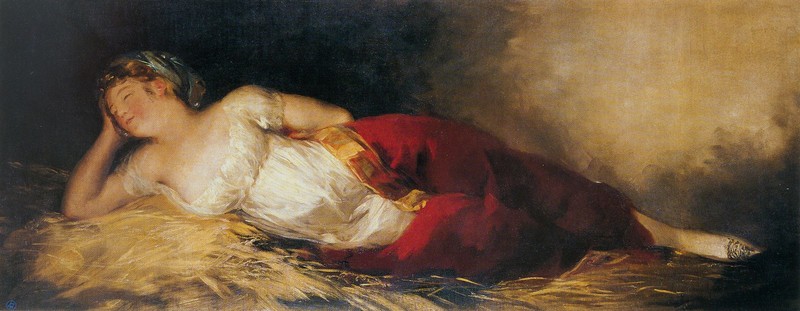- Cronología
- Ca. 1790 - 1793
- Ubicación
- Mac-Crohon Collection, Madrid, Spain
- Dimensiones
- 59 x 145 cm
- Técnica y soporte
- Oil on canvas
- Reconocimiento de la autoría de Goya
- Undisputed work
- Titular
- Mac-Crohon Collection
- Ficha: realización/revisión
- 25 Apr 2010 / 22 Nov 2022
- Otros títulos:
-
The Siesta (La siesta)
Sleepy Lady (Dama adormecida)
Young Woman Sleeping (Joven mujer dormida)
This canvas came from the collection of Francisco Acebal de Arratia y Aguirre, who would have purchased it from Javier Goya. It was inherited by Antonio Mc-Crohon, whose collection was based in Madrid.
Some scholars have stated that this could be one of the three overdoor pieces painted for Goya's friend and merchant Sebastián Martínez during the artist's stay in Cádiz between 1792 and 1793. The two other works commissioned at the same time would therefore have been Gossiping Women and The Dream, this last one being smaller in size, probably after being cut down.
The woman in this painting is lying on her side, fast asleep. Her head is resting on her right hand whilst her left hand is hidden behind her body. She is wearing a pale-coloured, low-cut dress, which the painter probably kept simple in order to emphasize the woman's face and bust. Her hips and legs are covered by what appears to be a small blanket.
The way in which light has been used here suggests a parallelism between this work and Gossiping Women. We might also say that, with this painting, Goya was tackling the same theme as that depicted in the other work, that of a woman sleeping peacefully, but from a different angle. The two works may have been made in the same period (rec. no.).
Due to the woman's posture and her clothing, Gudiol has established a connection between this painting and both The Marchioness of Santa Cruz and The Majas. There also exist some similarities between Sleeping Woman and Mary Magdalene (María Magdalena), by Gaspar Becerra (Baeza, 1520-Madrid, 1568), from which work Goya could have borrowed the sitter's posture and the lighting.
-
GoyaBasle2021p. 232
-
L'œuvre peint de Goya. 4 volsParís1928-1950p. 285, cat. 538
-
Goya and his sittersNew YorkThe Hispanic Society of America1964p. 9, il. 18
-
Vie et ouvre de Francisco de GoyaParísOffice du livre1970p. 90, cat. 308
-
L’opera pittorica completa di GoyaMilanRizzoli1974p. 104, cat. 244
-
Goya, Das Zeitalter de Revolutionen. 1789-1830HamburgPrestel-Verlag Münche und Hamburger Kunsthalle1980p. 323, il. 161
